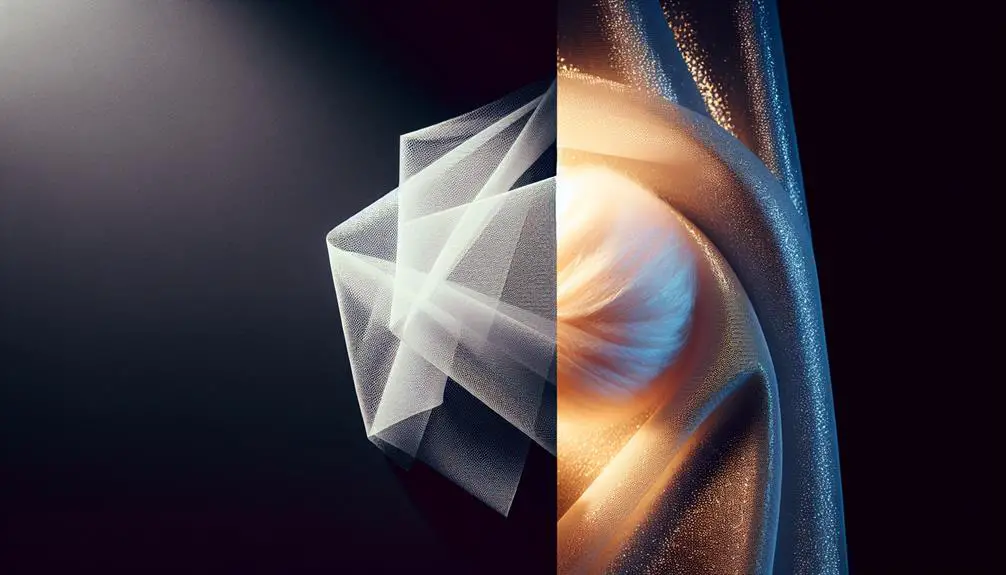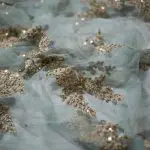I've always been curious about the differences between organza and organza silk. Essentially, both are lightweight, sheer fabrics known for their crisp texture. However, organza silk stands out due to its use of high-quality silk fibers, which give it a more luxurious feel and smoother, flowing texture. Regular organza often incorporates synthetic materials, making it less expensive but also less soft. Organza silk, with its exquisite drape and sheen, is pricier but perfect for elegant, flowy designs. Knowing these differences can really enhance how you choose materials for projects. There's a lot more to uncover about their unique advantages.
Table of Contents
Key Takeaways
- Organza is typically made from synthetic fibers, while organza silk is crafted from high-quality silk fibers.
- Organza silk offers a smoother, more flowing texture compared to the crisper texture of regular organza.
- Organza silk typically has a higher sheen and transparency than standard organza, enhancing its luxurious appeal.
- Due to its silk composition, organza silk is generally more expensive, ranging between $15 to $30 per yard.
- Organza silk is ideal for designs requiring soft draping, whereas regular organza is better for structured, voluminous garments.
Defining Organza
Organza is a thin, sheer fabric traditionally made from silk, known for its crisp texture and delicate appearance. When I first came across organza, I was struck by its ethereal quality, almost like a whisper of fabric. It's incredibly lightweight and has a slight sheen that catches the light beautifully, making it a favorite for evening wear and bridal gowns. What really sets organza apart, though, is its stiffness. Unlike other sheer fabrics that might drape softly, organza has a structured drape due to its tight weave.
This fabric isn't just about looks; it's highly functional too. The stiffness makes it great for creating volume and shapes that hold. That's why you'll often see it used in sleeves, overlays, and full skirts where you want to add a bit of drama without the heaviness. It's also surprisingly durable for such a light fabric, able to withstand multiple wears with proper care.
When I use organza in my projects, I'm careful with it. It can fray and snag easily, so I always use sharp scissors and handle it with care. But the results are always worth that extra attention—organza adds a touch of magic to any piece.
Origins of Organza Silk
While exploring the qualities of organza, I became curious about how organza silk specifically came to be. Diving into its origins, I found that organza silk has a rich history, deeply intertwined with the silk trade routes that spanned Asia and Europe. Originally, the material hailed from Central Asia, finding its way into the hands of skilled weavers in China and India, where silk production was a well-established craft.
The journey of organza silk began as a variation of the traditional organza made from silk fibers instead of synthetic ones. The desire for a more luxurious and natural fabric drove this evolution. Silk, known for its strength and natural sheen, was combined with the traditional weaving techniques of organza to create a fabric that maintained the crispness and transparency of organza but with the added benefits of silk.
This transition wasn't just about material improvement; it reflected the cultural exchanges along the Silk Road. As traders and merchants shared goods and knowledge, silk organza became a symbol of sophistication and craftsmanship, appreciated across continents for its beauty and practicality. It's fascinating how a simple curiosity about fabric can unravel stories that weave through time and history.
Material Composition
Delving into the material composition, we find that organza silk blends pure silk fibers with a lightweight, plain weave structure. This unique combination gives organza silk its characteristic crisp and sheer texture, which is quite different from regular organza made from synthetic materials like polyester or nylon. The inclusion of silk not only enhances the fabric's aesthetic appeal but also contributes to its softness and natural sheen.
Organza silk's structure involves tightly twisted fibers woven in a balanced plain weave. The crosswise and lengthwise threads pass over and under each other alternately, creating a fine mesh-like effect. This method results in a fabric that's both delicate and robust enough for various uses, from fashion to drapery. The silk fibers used are often of high quality, ensuring that the fabric feels luxurious and drapes beautifully.
While regular organza might sometimes feel stiff and synthetic, organza silk maintains a smoother and more flowing texture due to its natural fiber content. It's this blend of practicality and elegance that makes it a favorite for those looking to combine durability with a touch of class in their fabric choices. This understanding of material composition is essential for anyone aiming to master the differences and applications of these fabrics.
Durability and Maintenance
When considering the durability and maintenance of organza silk, it's crucial to note that this fabric requires careful handling to preserve its elegant appearance. Although organza silk offers a decent level of durability due to its silk fibers, it's more delicate compared to fabrics like cotton or denim.
To keep my organza silk items in top shape, I always follow specific care guidelines. First off, I avoid washing them in a regular washing machine. The agitation and spin cycles can be too harsh, leading to snags or tears. Instead, I opt for hand washing with a gentle detergent and lukewarm water. This method helps maintain the integrity of the fibers.
Drying is another critical aspect. I never wring out my organza silk garments; it's all about gentle handling. I lay them flat on a clean, dry towel and roll it up to absorb the excess water, then unroll and air dry the fabric away from direct sunlight. This prevents any shrinkage or warping of the delicate material.
When it comes to ironing, I set my iron to a low heat and use a pressing cloth between the iron and the organza silk. This keeps the fabric from getting scorched. By following these steps, I ensure my organza silk stays pristine for longer.
Transparency and Sheen
One striking feature of organza, especially organza silk, is its remarkable transparency and lustrous sheen. When I'm choosing fabric for a project that needs a touch of elegance and delicacy, organza silk is often my top pick due to these properties. Its transparency allows for layering without bulk, creating a depth that's both sophisticated and light. Meanwhile, the sheen adds a radiant glow that enhances the fabric's visual appeal, making it a favorite for evening wear and decorative overlays.
Here's a simple table that illustrates the key aspects of organza and organza silk in terms of transparency and sheen:
| Feature | Organza | Organza Silk |
|---|---|---|
| Transparency | High | Very High |
| Sheen | Moderate | High |
| Light Reflection | Good | Excellent |
| Texture | Crisp | Smoother and softer |
| Preferred Use | Decor, lighter fashion items | Evening wear, luxury garments |
This comparison highlights that while both materials share some characteristics, organza silk typically offers a higher degree of transparency and a more pronounced sheen. This makes it particularly suitable for those pieces where a light, airy, and shimmering effect is desired.
Varieties of Organza
Exploring further, let's look at the different types of organza available on the market. Traditionally, organza was made from silk, giving it a luxurious feel and delicate sheen. This type is often referred to as silk organza and remains a favorite for high-end fashion and bridal wear due to its fine quality and elegance.
However, as demand grew and technology advanced, manufacturers began producing organza from synthetic fibers like polyester and nylon. These versions are more affordable and offer greater durability and resistance to wrinkles compared to their silk counterparts. Polyester organza, in particular, is widely used for decorations, such as curtains and event backdrops, because it's less prone to damage and easier to maintain.
There's also a blend known as silk-polyester organza, which combines the best of both worlds. It maintains some of the softness and luster of silk while integrating the strength and resilience of polyester. This type is particularly popular for making dancewear and costumes that require a bit of glam without sacrificing durability.
Each type of organza holds its own charm and serves different purposes. Knowing these varieties helps you choose the right fabric for your specific needs, whether for fashion, decoration, or crafts.
Cost Comparison
Let's now compare the costs of different types of organza to see which might suit your budget. When I first started learning about fabric, I found it crucial to understand how much materials might set me back. So, I'm going to break down the typical costs you might run into when choosing between standard organza and the more luxurious organza silk.
Here's a simple table to give you a clearer idea:
| Type | Average Cost per Yard | Suitability for Tight Budgets |
|---|---|---|
| Standard Organza | $4 – $7 | Good |
| Organza Silk | $15 – $30 | Poor |
| Polyester Organza | $3 – $5 | Best |
Standard organza is often your best bet if you're watching your pennies. It's pretty, versatile, and doesn't hit the wallet too hard. Polyester organza is even cheaper and quite durable, making it a winner for those who need to keep costs down. On the other hand, organza silk, while stunning and luxurious, does come with a higher price tag. It's definitely more of a splurge. Each type has its perks, so your choice really hinges on what's more important to you: cost or luxe appeal.
Common Uses and Applications
After covering the costs, I'll now discuss how different types of organza are used in various applications. Organza's unique qualities make it a favorite in the world of fashion and décor. I've seen it used primarily in evening and bridal wear. Its sheer, lightweight nature adds a touch of elegance without the bulk, making it perfect for flowy, fairy-tale gowns. It's not just about dresses, though. Organza is also great for crafting decorative overlays and sashes that add depth and sophistication to outfits.
Beyond fashion, organza finds its place in home décor. It's often used for sheer curtains that filter light softly into rooms, creating a warm, inviting atmosphere. Similarly, it's popular in table decorations, such as runners and chair tie-backs for weddings and other events. It gives a luxe, airy feel that's quite enchanting.
In the arts, organza is a go-to material for creating artificial flowers and other delicate, intricate craft projects. Its ability to hold shape while remaining ethereal is a real advantage for creative designs that require both structure and beauty. This versatility across different fields is what makes organza, whether silk-based or synthetic, such a sought-after material.
Choosing the Right Organza
Choosing the right organza often depends on the specific needs of your project. If you're crafting something that needs a bit of stiffness and structure, like a bridal gown or a tutu, you'll want to go for regular organza. It's got that crisp feel which holds shapes wonderfully. On the other hand, if you're after something with a bit more flow or a luxurious touch, organza silk is your friend. It drapes beautifully and feels softer against the skin, making it perfect for flowy dresses or scarves.
You'll also need to consider the finish and weight. Organza can come in a variety of finishes, some are matte while others have a slight sheen. Think about what look you're aiming for. A matte finish might be great for crafting purposes, while a sheen can add a touch of elegance to evening wear. The weight of the organza affects its transparency and how it falls. Heavier weights are less see-through and provide more structure, whereas lighter ones are more delicate and transparent.
Lastly, don't forget about color! Organza comes in a wide range of colors. Choosing the right shade can make your project pop or give it that subtle elegance you're looking for.
Frequently Asked Questions
Can Organza Fabric Cause Allergic Reactions?
Yes, organza fabric can cause allergic reactions. It's not the fabric itself, but the chemicals used in processing that might irritate sensitive skin. Always check the material blend and finish used.
Is Organza Suitable for Winter Clothing?
I wouldn't recommend organza for winter clothing; it's too sheer and lightweight. For cold weather, you'll need something thicker to keep you warm, like wool or fleece.
How Is Organza Perceived in High Fashion?
In high fashion, organza's like a whisper of elegance; it's sheer and adds a touch of sophistication. Designers often use it for its crisp texture and ability to create voluminous yet delicate silhouettes.
Are There Eco-Friendly Versions of Organza?
Yes, there are eco-friendly versions of organza made from sustainable materials like silk or recycled polyester. They offer a greener option while maintaining the fabric's characteristic lightweight and sheer qualities.
Can Organza Be Dyed at Home?
Yes, I've discovered that you can dye organza at home using acid dyes or fabric paints. It's a fun project, but ensure you handle the delicate fabric gently to maintain its sheen.
- Tetron Fabric for Marine Applications: Durability and Use Cases - June 18, 2025
- Tetron Fabric for Outdoor Furniture: Weather Resistance and Care - June 18, 2025
- Tetron Fabric for Wall Coverings: Style and Application Tips - June 18, 2025





